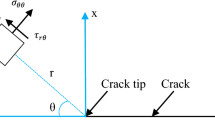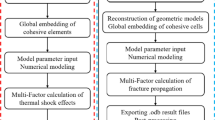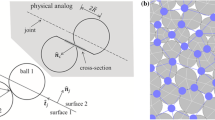Abstract
Hydraulic fracturing in combination with horizontal well has been widely used to stimulate shale oil and gas from reservoirs. Numerical simulation of hydraulic fracturing is a great challenge due to the geological complexity of reservoirs. In this paper, a fully coupled fluid flow, plastic deformation and fracture propagation model is presented based on cohesive zone method. An implicit algorithm to discretize and integrate the fully coupled differential equations is presented. Plastic deformation is observed in the vicinity of hydraulic fracture during the stimulation process. The effect of plastic and stimulation parameters on fracture propagation behaviors has been investigated. The energy dissipation induced by the plastic deformation increases the fracture width. The fracture propagation behaviors both in viscosity and toughness dominated regimes are discussed. The evolution formula of non-dimensional fracture length at different regimes is presented by fitting numerical results.













Similar content being viewed by others
References
Areias P, Rabczuk T (2010) Smooth finite strain plasticity with non-local pressure support. Int J Numer Meth Eng 81(1):106–134
Areias P, Rabczuk T, De Sá JC (2015) Semi-implicit finite strain constitutive integration of porous plasticity models. Finite Elem Anal Des 104:41–55
Areias P, Msekh M, Rabczuk T (2016) Damage and fracture algorithm using the screened Poisson equation and local remeshing. Eng Fract Mech 158:116–143
Areias P, Rabczuk T, Msekh M (2016) Phase-field analysis of finite-strain plates and shells including element subdivision. Comput Methods Appl Mech Eng 312:322–350
Areias P, Reinoso J, Camanho P, De Sá JC, Rabczuk T (2018) Effective 2d and 3d crack propagation with local mesh refinement and the screened Poisson equation. Eng Fract Mech 189:339–360
Asahina D, Pan P, Tsusaka K, Takeda M, Bolander JE (2018) Simulating hydraulic fracturing processes in laboratory-scale geological media using three-dimensional tough-RBSN. J Rock Mech Geotech Eng 10(6):1102–1111
Batchelor CK, Batchelor G (2000) An introduction to fluid dynamics. Cambridge University Press, Cambridge
Chen Z (2012) Finite element modelling of viscosity-dominated hydraulic fractures. J Petrol Sci Eng 88:136–144
Chen Z, Jeffrey RG, Zhang X, Kear J (2018) Finite-element simulation of a hydraulic fracture interacting with a natural fracture. SPE J 22(01):219–234
Chen J, Lan H, Macciotta R, Martin CD, Wu Y (2021) Microfracture characterization of shale constrained by mineralogy and bedding. J Petrol Sci Eng 201:108456
de Souza Neto EA, Peric D, Owen DR (2011) Computational methods for plasticity: theory and applications. Wiley, New York
Dontsov E, Peirce A (2014) Slurry flow, gravitational settling, and a proppant transport model for hydraulic fractures
Fu P, Johnson SM, Carrigan CR (2013) An explicitly coupled hydro-geomechanical model for simulating hydraulic fracturing in arbitrary discrete fracture networks. Int J Numer Anal Meth Geomech 37(14):2278–2300
Goswami S, Anitescu C, Chakraborty S, Rabczuk T (2020) Transfer learning enhanced physics informed neural network for phase-field modeling of fracture. Theoret Appl Fract Mech 106:102447
Grasle W, Plischke I (2010) LT-A experiment: mechanical behavior of Opalinus clay, data report from phase 15. Mont Terri Technical Note TN 86:2011
Gräsle W, Plischke I (2011) LT-A experiment: mechanical behavior of Opalinus clay, data report from phase 15. Mont Terri Technical Note TN 2010:86
Guo H, Zhuang X, Chen P, Alajlan N, Rabczuk T (2022) Stochastic deep collocation method based on neural architecture search and transfer learning for heterogeneous porous media. Eng Comput pp 1–26
Hu Y, Wang Q, Zhao J, Chen S, Li D, Xu R, Zhao C (2021) Numerical simulation of complex fracture geometry caused by hydrodynamics in shale with pre-existing weak planes. J Petrol Sci Eng 199:108306
Huang L, Liu J, Zhang F, Dontsov E, Damjanac B (2019) Exploring the influence of rock inherent heterogeneity and grain size on hydraulic fracturing using discrete element modeling. Int J Solids Struct 176:207–220
Janiszewski M, Shen B, Rinne M (2019) Simulation of the interactions between hydraulic and natural fractures using a fracture mechanics approach. J Rock Mech Geotech Eng 11(6):1138–1150
Karniadakis GE, Kevrekidis IG, Lu L, Perdikaris P, Wang S, Yang L (2021) Physics-informed machine learning. Nat Rev Phys 3(6):422–440
Kristensen PK, Martínez-Pañeda E (2020) Phase field fracture modelling using quasi-newton methods and a new adaptive step scheme. Theoret Appl Fract Mech 107:102446
Lawal AI, Kwon S (2021) Application of artificial intelligence to rock mechanics: an overview. J Rock Mech Geotech Eng 13(1):248–266
Lee S, Wheeler MF, Wick T (2016) Pressure and fluid-driven fracture propagation in porous media using an adaptive finite element phase field model. Comput Methods Appl Mech Eng 305:111–132
Li C, Caner FC, Chau VT, Bažant ZP (2017) Spherocylindrical microplane constitutive model for shale and other anisotropic rocks. J Mech Phys Solids 103:155–178
Li Y, Jia D, Rui Z, Peng J, Fu C, Zhang J (2017) Evaluation method of rock brittleness based on statistical constitutive relations for rock damage. J Petrol Sci Eng 153:123–132
Li C, Xie H, Wang J (2020) Anisotropic characteristics of crack initiation and crack damage thresholds for shale. Int J Rock Mech Min Sci 126:104178
Liu C, Shi F, Zhang Y, Zhang Y, Deng D, Wang X, Liu H, Wu H (2017) High injection rate stimulation for improving the fracture complexity in tight-oil sandstone reservoirs. J Nat Gas Sci Eng 42:133–141
Liu C, Shen Y, Zhang J, Lu D, Liu H, Wu H (2019) Production analysis in shale gas reservoirs based on fracturing-enhanced permeability areas. Sci China Phys Mech Astron 62(10):1–9
Liu C, Zhang J, Yu H, Chen J, Lu D, Wu H (2020) New insights of natural fractures growth and stimulation optimization based on a three-dimensional cohesive zone model. J Nat Gas Sci Eng 76:103165
Lu Y, Wang L, Ge Z, Zhou Z, Deng K, Zuo S (2020) Fracture and pore structure dynamic evolution of coals during hydraulic fracturing. Fuel 259:116272
Miehe C, Mauthe S (2016) Phase field modeling of fracture in multi-physics problems. part III. crack driving forces in hydro-poro-elasticity and hydraulic fracturing of fluid-saturated porous media. Comput Methods Appl Mech Eng 304:619–655
Miller CK, Waters GA, Rylander EI et al. (2011) Evaluation of production log data from horizontal wells drilled in organic shales. In: North American unconventional gas conference and exhibition. Society of Petroleum Engineers
Nejati M, Aminzadeh A, Amann F, Saar MO, Driesner T (2020) Mode i fracture growth in anisotropic rocks: theory and experiment. Int J Solids Struct 195:74–90
Ni T, Pesavento F, Zaccariotto M, Galvanetto U, Zhu Q-Z, Schrefler BA (2020) Hybrid fem and peridynamic simulation of hydraulic fracture propagation in saturated porous media. Comput Methods Appl Mech Eng 366:113101
Niazi S, Chen Z, Bobaru F (2021) Crack nucleation in brittle and quasi-brittle materials: a peridynamic analysis. Theoret Appl Fract Mech 112:102855
Ortiz M, Pandolfi A (1999) Finite-deformation irreversible cohesive elements for three-dimensional crack-propagation analysis. Int J Numer Meth Eng 44(9):1267–1282
Ouchi H, Foster JT, Sharma MM (2017) Effect of reservoir heterogeneity on the vertical migration of hydraulic fractures. J Petrol Sci Eng 151:384–408
Parisio F, Samat S, Laloui L (2015) Constitutive analysis of shale: a coupled damage plasticity approach. Int J Solids Struct 75:88–98
Rabczuk T, Belytschko T (2004) Cracking particles: a simplified meshfree method for arbitrary evolving cracks. Int J Numer Meth Eng 61(13):2316–2343
Rabczuk T, Gracie R, Song J-H, Belytschko T (2010) Immersed particle method for fluid-structure interaction. Int J Numer Meth Eng 81(1):48–71
Ren H, Zhuang X, Cai Y, Rabczuk T (2016) Dual-horizon peridynamics. Int J Numer Meth Eng 108(12):1451–1476
Ren H, Zhuang X, Anitescu C, Rabczuk T (2019) An explicit phase field method for brittle dynamic fracture. Comput Struct 217:45–56
Rice J (1979) The mechanics of earthquake rupture. Division of Engineering, Brown University Providence, Providence
Samaniego E, Anitescu C, Goswami S, Nguyen-Thanh VM, Guo H, Hamdia K, Zhuang X, Rabczuk T (2020) An energy approach to the solution of partial differential equations in computational mechanics via machine learning: Concepts, implementation and applications. Comput Methods Appl Mech Eng 362:112790
Savitski A, Detournay E (2002) Propagation of a penny-shaped fluid-driven fracture in an impermeable rock: asymptotic solutions. Int J Solids Struct 39(26):6311–6337
Shen X, Standifird W (2017) Numerical simulation in hydraulic fracturing: multiphysics theory and applications, vol 1. CRC Press, Boca Raton
Shen W, Zhao Y-P (2018) Combined effect of pressure and shear stress on penny-shaped fluid-driven cracks. J Appl Mech 85(3)
Shi F (2021) Xfem-based numerical modeling of well performance considering proppant transport, embedment, crushing and rock creep in shale gas reservoirs. J Petrol Sci Eng 201:108523
Simo JC, Hughes TJ (2006) Computational inelasticity, vol 7. Springer, New York
Sneddon I, Elliot H (1946) The opening of a Griffith crack under internal pressure. Q Appl Math 4(3):262–267
Soliman MY, East L, Augustine J (2010) Fracturing design aimed at enhancing fracture complexity. In: SPE EUROPEC/EAGE annual conference and exhibition. OnePetro
Tang J, Wu K, Zuo L, Xiao L, Sun S, Ehlig-Economides C et al (2019) Investigation of rupture and slip mechanisms of hydraulic fractures in multiple-layered formations. SPE J 24(05):2–292
Tomar V, Zhai J, Zhou M (2004) Bounds for element size in a variable stiffness cohesive finite element model. Int J Numer Meth Eng 61(11):1894–1920
Wen S, Zhang C, Chang Y, Hu P (2020) Dynamic compression characteristics of layered rock mass of significant strength changes in adjacent layers. J Rock Mech Geotech Eng 12(2):353–365
Wilson ZA, Landis CM (2016) Phase-field modeling of hydraulic fracture. J Mech Phys Solids 96:264–290
Xu Y, Yao W, Xia K (2020) Numerical study on tensile failures of heterogeneous rocks. J Rock Mech Geotech Eng 12(1):50–58
York JR et al. (2018). Advanced hydraulic fracture modeling: peridynamics, inelasticity, and coupling to FEM. PhD thesis
Zeng Q, Liu Z, Wang T, Gao Y, Zhuang Z (2018) Fully coupled simulation of multiple hydraulic fractures to propagate simultaneously from a perforated horizontal wellbore. Comput Mech 61(1):137–155
Zhao G, Chen C, Yan H (2019) A thermal damage constitutive model for oil shale based on Weibull statistical theory. Math Probl Eng
Zheng S, Hwang J, Manchanda R, Sharma MM (2021) An integrated model for non-isothermal multi-phase flow, geomechanics and fracture propagation. J Petrol Sci Eng 196:107716
Zhou S, Zhuang X, Zhu H, Rabczuk T (2018) Phase field modelling of crack propagation, branching and coalescence in rocks. Theoret Appl Fract Mech 96:174–192
Zhou S, Zhuang X, Rabczuk T (2019) Phase-field modeling of fluid-driven dynamic cracking in porous media. Comput Methods Appl Mech Eng 350:169–198
Zhou X, Lu D, Su C, Gao Z, Du X (2022) An unconstrained stress updating algorithm with the line search method for elastoplastic soil models. Comput Geotech 143:104592
Zhuang X, Zhou S, Sheng M, Li G (2020) On the hydraulic fracturing in naturally-layered porous media using the phase field method. Eng Geol 266:105306
Zou J, Jiao Y-Y, Tan F, Lv J, Zhang Q (2021) Complex hydraulic-fracture-network propagation in a naturally fractured reservoir. Comput Geotech 135:104165
Acknowledgements
This work was jointly supported byNational Natural Science Foundation of China (12102173), Anhui Provincial Natural Science Foundation (1908085QA32) and General Project of Natural Science Research in Universities of Jiangsu Province (21KJB130001).
Author information
Authors and Affiliations
Contributions
Conceptualization: CL; Methodology: CL; Analysis and investigation: CL, ZW; Writing: CL; Supervision: CL.
Corresponding author
Additional information
Publisher's Note
Springer Nature remains neutral with regard to jurisdictional claims in published maps and institutional affiliations.
Rights and permissions
Springer Nature or its licensor holds exclusive rights to this article under a publishing agreement with the author(s) or other rightsholder(s); author self-archiving of the accepted manuscript version of this article is solely governed by the terms of such publishing agreement and applicable law.
About this article
Cite this article
Liu, C., Wang, Z. Numerical simulation of hydraulic fracture propagation in shale with plastic deformation. Int J Fract 238, 115–132 (2022). https://doi.org/10.1007/s10704-022-00659-7
Received:
Accepted:
Published:
Issue Date:
DOI: https://doi.org/10.1007/s10704-022-00659-7




